Nutrition Program and Proposal: Childhood Obesity Management
VerifiedAdded on 2022/09/08
|15
|1352
|11
Project
AI Summary
This project proposes a randomized controlled trial to assess the effectiveness of a nutrition and educational weight management program for childhood obesity. The program aims to compare weight loss, nutritional knowledge, and compliance between two groups: one receiving written nutritional guidelines and the other participating in interactive educational sessions involving both parents and children, alongside pictorial and written resources for balanced diets. The study is grounded in the trans-theoretical model of change and focuses on children aged 6-11 with a BMI above 23.9 kg/m2. The research design includes pre- and post-intervention assessments of weight using MDQI to measure nutritional knowledge and compliance. The proposal details the rationale, theoretical foundation, hypothesis, aims, design, sample size, sampling methods, inclusion/exclusion criteria, methods, outcomes, and a sustainability plan to ensure the program's long-term viability. The project emphasizes parental involvement and the need for increased awareness of childhood obesity's effects.
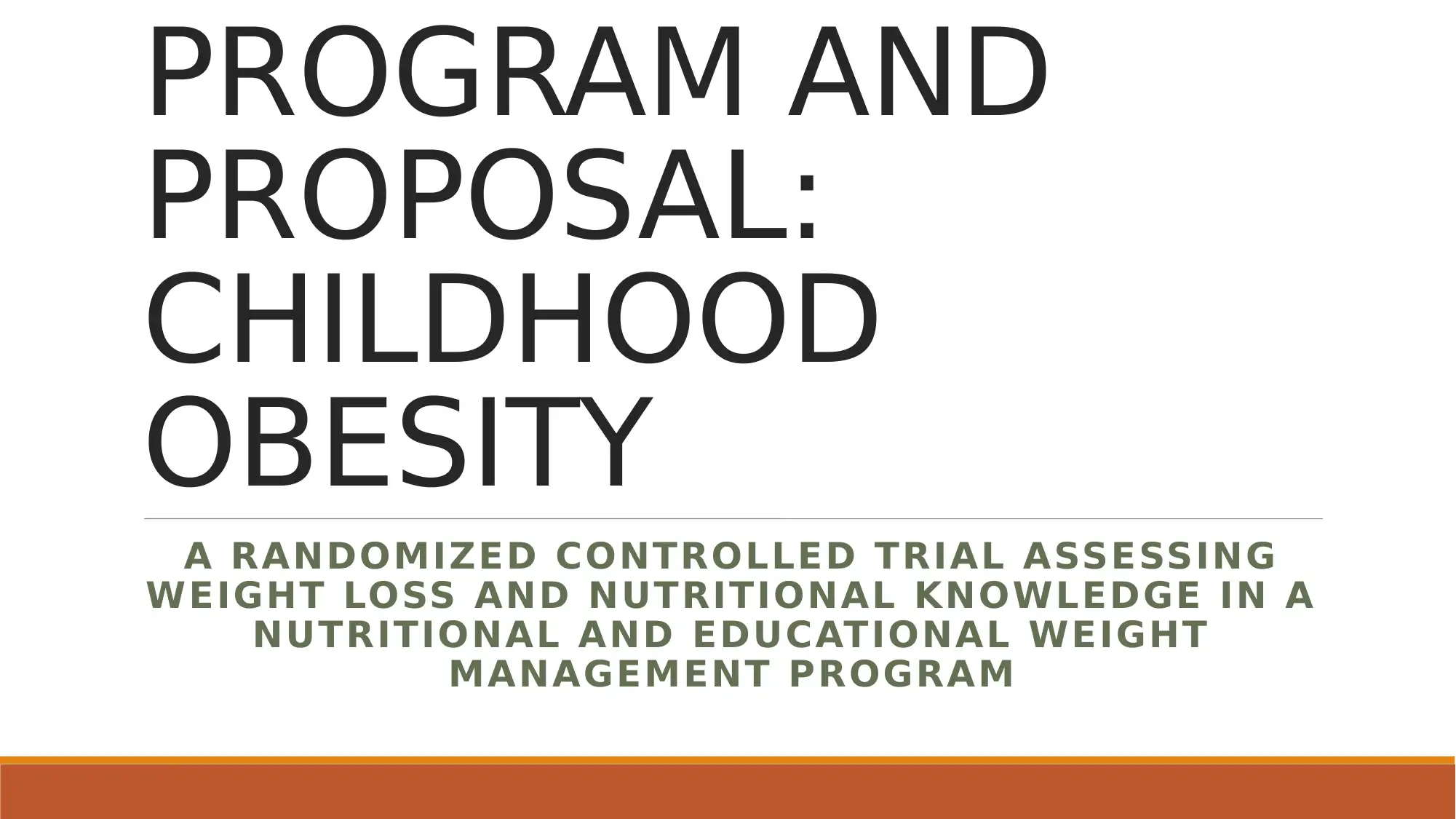
PROGRAM AND
PROPOSAL:
CHILDHOOD
OBESITY
A RANDOMIZED CONTROLLED TRIAL ASSESSING
WEIGHT LOSS AND NUTRITIONAL KNOWLEDGE IN A
NUTRITIONAL AND EDUCATIONAL WEIGHT
MANAGEMENT PROGRAM
PROPOSAL:
CHILDHOOD
OBESITY
A RANDOMIZED CONTROLLED TRIAL ASSESSING
WEIGHT LOSS AND NUTRITIONAL KNOWLEDGE IN A
NUTRITIONAL AND EDUCATIONAL WEIGHT
MANAGEMENT PROGRAM
Paraphrase This Document
Need a fresh take? Get an instant paraphrase of this document with our AI Paraphraser

Research Background
Obesity during childhood has been largely linked to perceptions and behaviors followed by parents [1].
The following program proposal thus intends to design an educational and behavioral intervention
program involving both children and parents for obesity management.
According to the qualitative, interview-based study conducted by [2] across 21 parents of children in
primary school, participants reported to enroll and involve themselves in a weight management
program for their children, only after engaging in a number of attempts which were unsuccessful.
Additionally, the authors also reported the influence of parent’s misperception regarding their child’s
weight – parents were found to underestimate or misunderstand a change in the weight of the child as
insignificant resulting in delayed enrolment.
Nevertheless, the cross sectional study by [3] aimed to assess associations between the weight status of
parents and obesity in children across 23043 children and their parents. It was found that for those
children with parents who are obese, the Odds Ratio for obesity in children were reported to be 3.46 for
females (OR=3.46; 95% CI=3.03-3.94) and 2.79 for males (OR=2.79; 95% CI=2.44-3.20) as compared to
children with parents who were not obese.
Obesity during childhood has been largely linked to perceptions and behaviors followed by parents [1].
The following program proposal thus intends to design an educational and behavioral intervention
program involving both children and parents for obesity management.
According to the qualitative, interview-based study conducted by [2] across 21 parents of children in
primary school, participants reported to enroll and involve themselves in a weight management
program for their children, only after engaging in a number of attempts which were unsuccessful.
Additionally, the authors also reported the influence of parent’s misperception regarding their child’s
weight – parents were found to underestimate or misunderstand a change in the weight of the child as
insignificant resulting in delayed enrolment.
Nevertheless, the cross sectional study by [3] aimed to assess associations between the weight status of
parents and obesity in children across 23043 children and their parents. It was found that for those
children with parents who are obese, the Odds Ratio for obesity in children were reported to be 3.46 for
females (OR=3.46; 95% CI=3.03-3.94) and 2.79 for males (OR=2.79; 95% CI=2.44-3.20) as compared to
children with parents who were not obese.
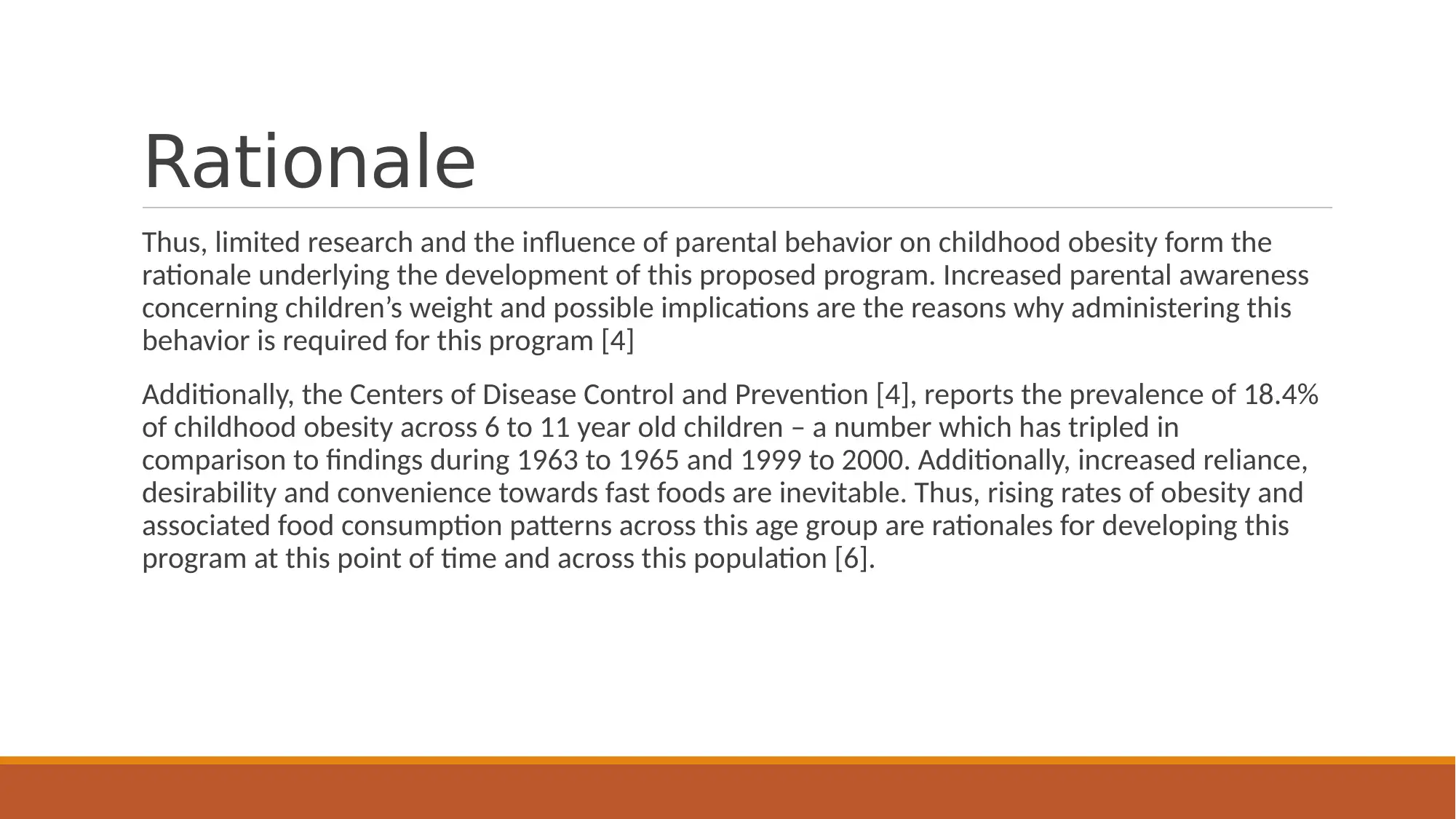
Rationale
Thus, limited research and the influence of parental behavior on childhood obesity form the
rationale underlying the development of this proposed program. Increased parental awareness
concerning children’s weight and possible implications are the reasons why administering this
behavior is required for this program [4]
Additionally, the Centers of Disease Control and Prevention [4], reports the prevalence of 18.4%
of childhood obesity across 6 to 11 year old children – a number which has tripled in
comparison to findings during 1963 to 1965 and 1999 to 2000. Additionally, increased reliance,
desirability and convenience towards fast foods are inevitable. Thus, rising rates of obesity and
associated food consumption patterns across this age group are rationales for developing this
program at this point of time and across this population [6].
Thus, limited research and the influence of parental behavior on childhood obesity form the
rationale underlying the development of this proposed program. Increased parental awareness
concerning children’s weight and possible implications are the reasons why administering this
behavior is required for this program [4]
Additionally, the Centers of Disease Control and Prevention [4], reports the prevalence of 18.4%
of childhood obesity across 6 to 11 year old children – a number which has tripled in
comparison to findings during 1963 to 1965 and 1999 to 2000. Additionally, increased reliance,
desirability and convenience towards fast foods are inevitable. Thus, rising rates of obesity and
associated food consumption patterns across this age group are rationales for developing this
program at this point of time and across this population [6].
⊘ This is a preview!⊘
Do you want full access?
Subscribe today to unlock all pages.

Trusted by 1+ million students worldwide

Theoretical Foundation
The trans-theoretical model of change will be used since it is based on the principle that
individuals are initially reluctant to change and specific interventions can increase their
readiness [7].
1. Pre-contemplation and Contemplation: Parents and children may be reluctant or
unmotivated due to reliance over current dietary patterns. Along with educational sessions,
group discussions will be used to encourage all parents and children to share their doubts
collectively. This is because peer groups, due to inclusion of participants with similar
objectives, generate greater understanding and participation.
2. Action and Termination: Nutritional and educational interventions will be implemented
involving both parents and children. After completion, subjective feedback follow ups will be
used for measuring sustainability [7].
The trans-theoretical model of change will be used since it is based on the principle that
individuals are initially reluctant to change and specific interventions can increase their
readiness [7].
1. Pre-contemplation and Contemplation: Parents and children may be reluctant or
unmotivated due to reliance over current dietary patterns. Along with educational sessions,
group discussions will be used to encourage all parents and children to share their doubts
collectively. This is because peer groups, due to inclusion of participants with similar
objectives, generate greater understanding and participation.
2. Action and Termination: Nutritional and educational interventions will be implemented
involving both parents and children. After completion, subjective feedback follow ups will be
used for measuring sustainability [7].
Paraphrase This Document
Need a fresh take? Get an instant paraphrase of this document with our AI Paraphraser

Hypothesis
Proposed Hypothesis: Implementation of a nutritional program involving both obese children as
well as deliverance of educational interventions to parents will contribute to greater loss in
weight, improved nutritional knowledge and compliance as compared to a nutritional program
involving only children.
Proposed Hypothesis: Implementation of a nutritional program involving both obese children as
well as deliverance of educational interventions to parents will contribute to greater loss in
weight, improved nutritional knowledge and compliance as compared to a nutritional program
involving only children.
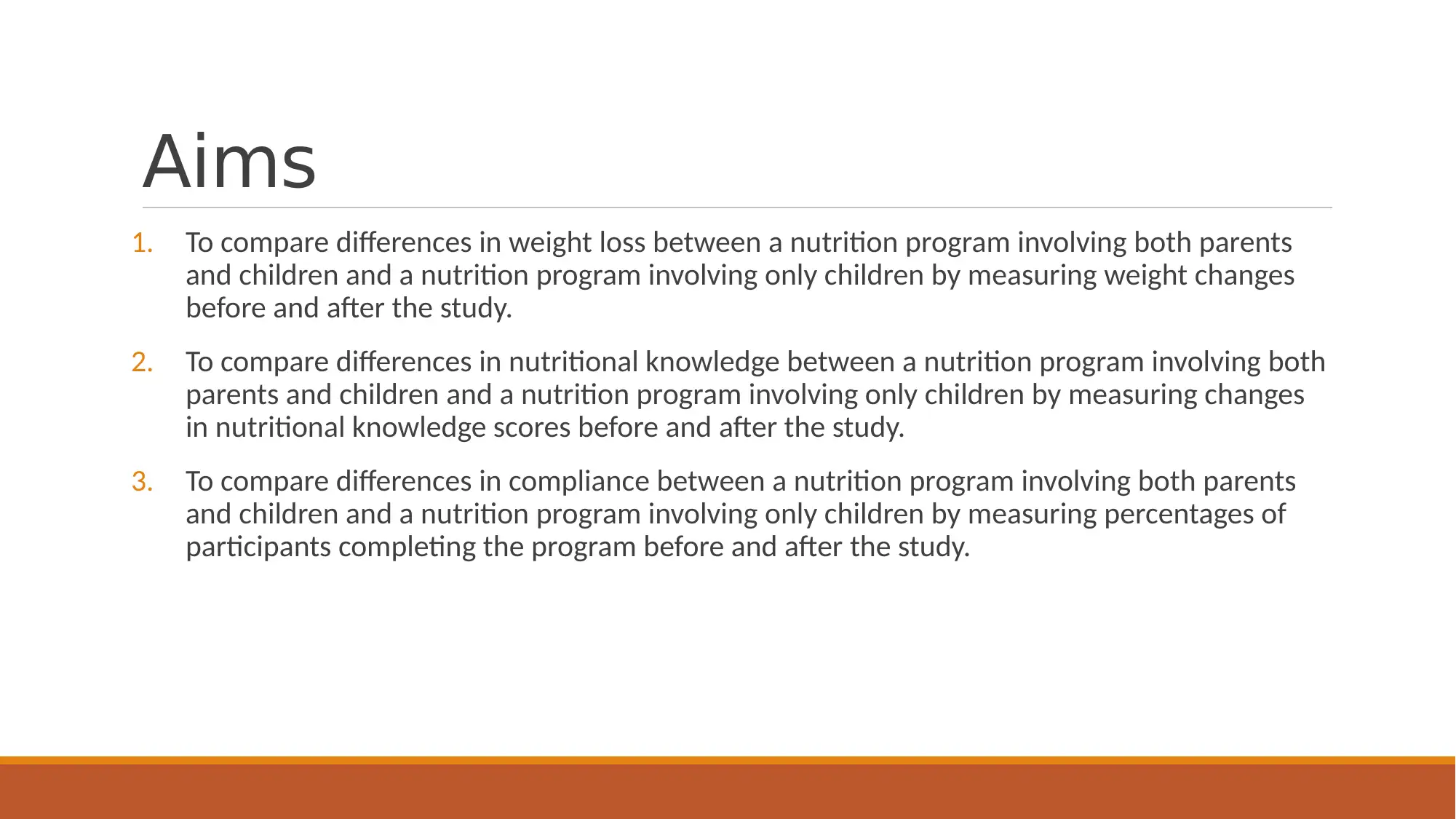
Aims
1. To compare differences in weight loss between a nutrition program involving both parents
and children and a nutrition program involving only children by measuring weight changes
before and after the study.
2. To compare differences in nutritional knowledge between a nutrition program involving both
parents and children and a nutrition program involving only children by measuring changes
in nutritional knowledge scores before and after the study.
3. To compare differences in compliance between a nutrition program involving both parents
and children and a nutrition program involving only children by measuring percentages of
participants completing the program before and after the study.
1. To compare differences in weight loss between a nutrition program involving both parents
and children and a nutrition program involving only children by measuring weight changes
before and after the study.
2. To compare differences in nutritional knowledge between a nutrition program involving both
parents and children and a nutrition program involving only children by measuring changes
in nutritional knowledge scores before and after the study.
3. To compare differences in compliance between a nutrition program involving both parents
and children and a nutrition program involving only children by measuring percentages of
participants completing the program before and after the study.
⊘ This is a preview!⊘
Do you want full access?
Subscribe today to unlock all pages.

Trusted by 1+ million students worldwide

Design
A randomized controlled trial will be used where the control group will comprise of parents and
obese children participating in a program where they will only receive written handouts of
nutritionally balanced, weight loss diets to follow. The experimental group will comprise of
parents and obese children participating in a program where both parents and children will be
involved in an educational, interactive session followed by being provided with pictorial and
written resources for balanced diet which both parents and children can follow. Both groups will
be evaluated for weight loss recorded before and after 3 months of interventions as well as
nutritional knowledge scores using the Mediterranean Diet Quality Index (MDQI). Both groups
will also be evaluated for trial completion [8].
A randomized controlled trial will be used where the control group will comprise of parents and
obese children participating in a program where they will only receive written handouts of
nutritionally balanced, weight loss diets to follow. The experimental group will comprise of
parents and obese children participating in a program where both parents and children will be
involved in an educational, interactive session followed by being provided with pictorial and
written resources for balanced diet which both parents and children can follow. Both groups will
be evaluated for weight loss recorded before and after 3 months of interventions as well as
nutritional knowledge scores using the Mediterranean Diet Quality Index (MDQI). Both groups
will also be evaluated for trial completion [8].
Paraphrase This Document
Need a fresh take? Get an instant paraphrase of this document with our AI Paraphraser
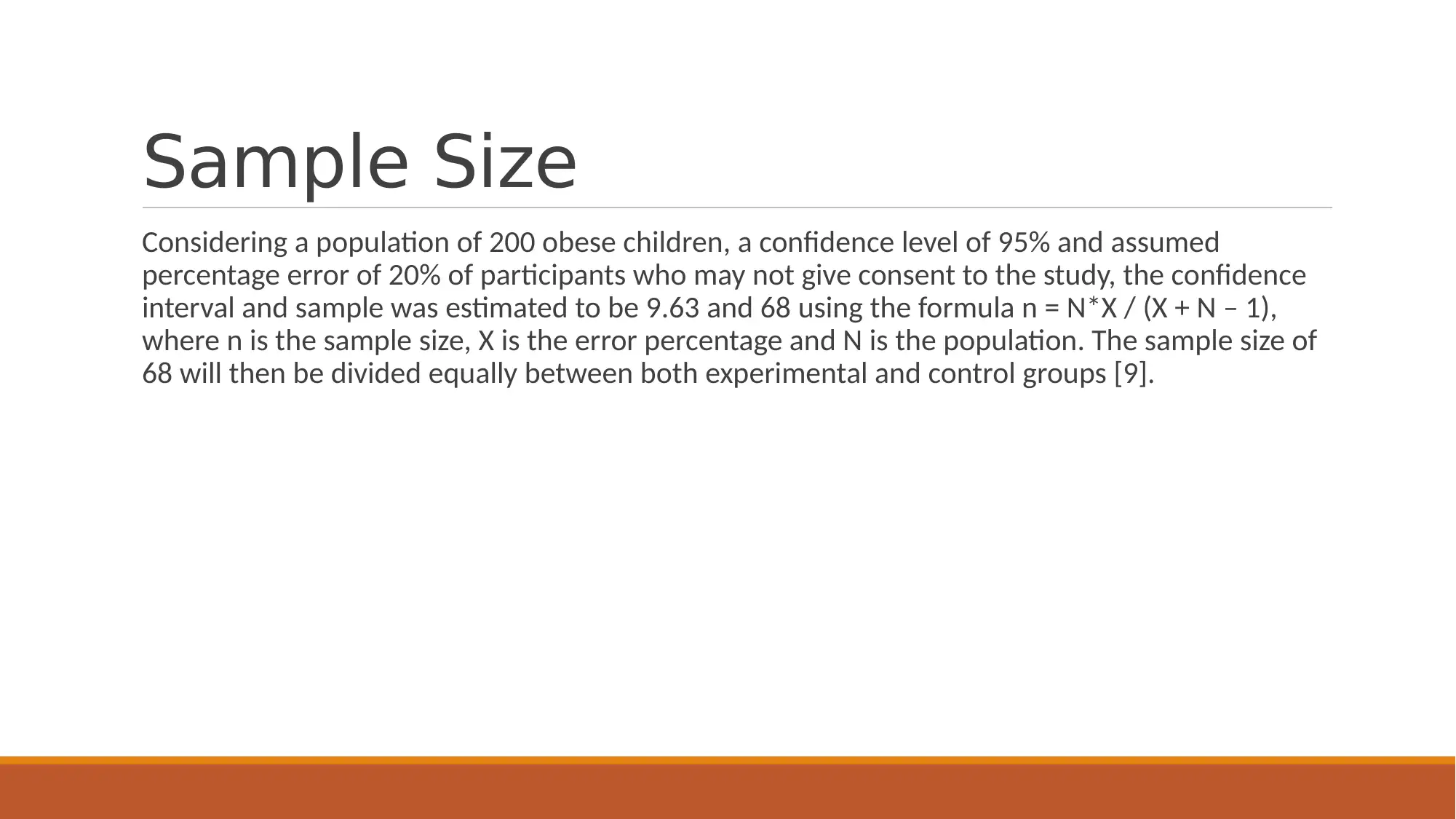
Sample Size
Considering a population of 200 obese children, a confidence level of 95% and assumed
percentage error of 20% of participants who may not give consent to the study, the confidence
interval and sample was estimated to be 9.63 and 68 using the formula n = N*X / (X + N – 1),
where n is the sample size, X is the error percentage and N is the population. The sample size of
68 will then be divided equally between both experimental and control groups [9].
Considering a population of 200 obese children, a confidence level of 95% and assumed
percentage error of 20% of participants who may not give consent to the study, the confidence
interval and sample was estimated to be 9.63 and 68 using the formula n = N*X / (X + N – 1),
where n is the sample size, X is the error percentage and N is the population. The sample size of
68 will then be divided equally between both experimental and control groups [9].
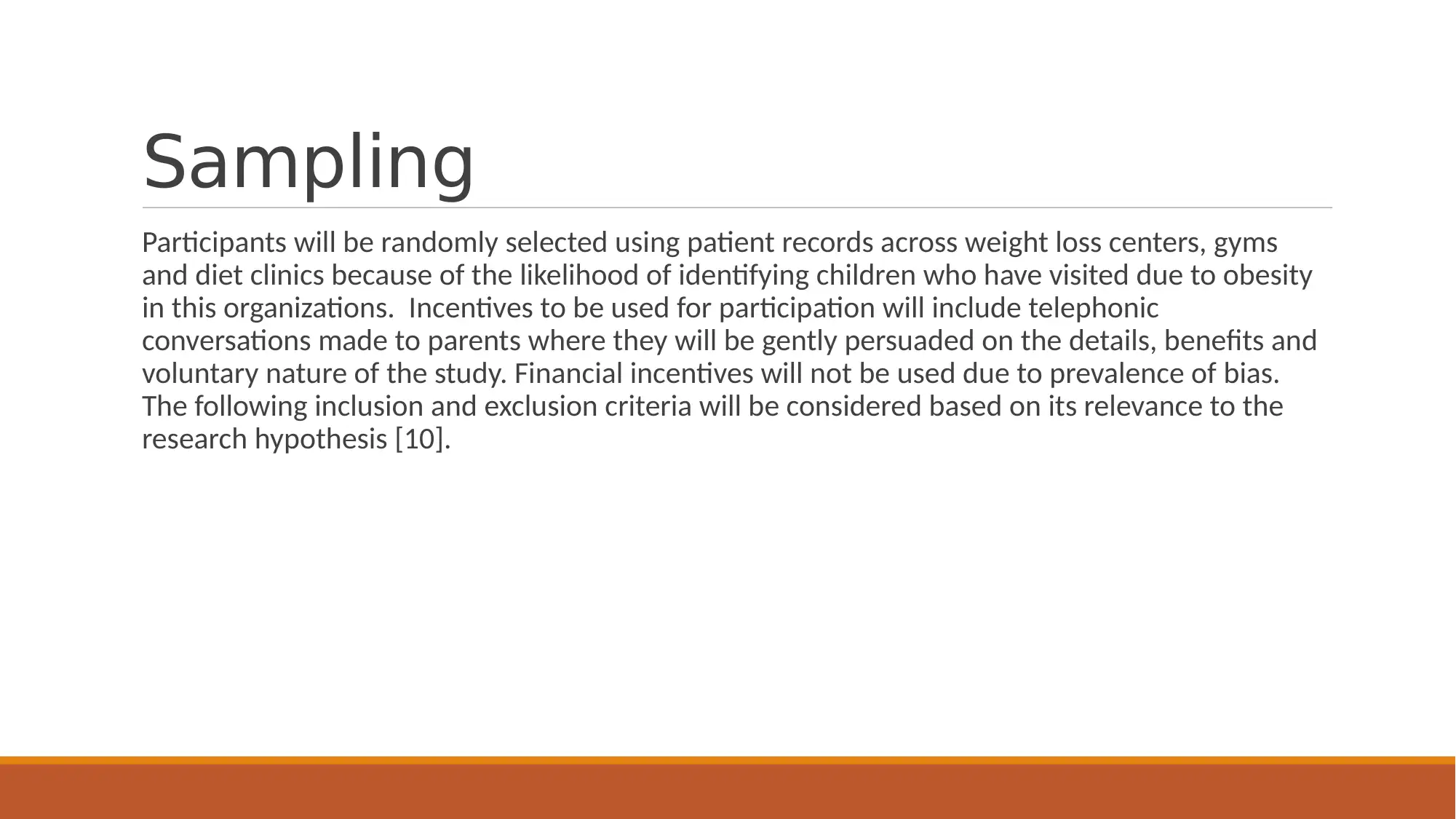
Sampling
Participants will be randomly selected using patient records across weight loss centers, gyms
and diet clinics because of the likelihood of identifying children who have visited due to obesity
in this organizations. Incentives to be used for participation will include telephonic
conversations made to parents where they will be gently persuaded on the details, benefits and
voluntary nature of the study. Financial incentives will not be used due to prevalence of bias.
The following inclusion and exclusion criteria will be considered based on its relevance to the
research hypothesis [10].
Participants will be randomly selected using patient records across weight loss centers, gyms
and diet clinics because of the likelihood of identifying children who have visited due to obesity
in this organizations. Incentives to be used for participation will include telephonic
conversations made to parents where they will be gently persuaded on the details, benefits and
voluntary nature of the study. Financial incentives will not be used due to prevalence of bias.
The following inclusion and exclusion criteria will be considered based on its relevance to the
research hypothesis [10].
⊘ This is a preview!⊘
Do you want full access?
Subscribe today to unlock all pages.

Trusted by 1+ million students worldwide
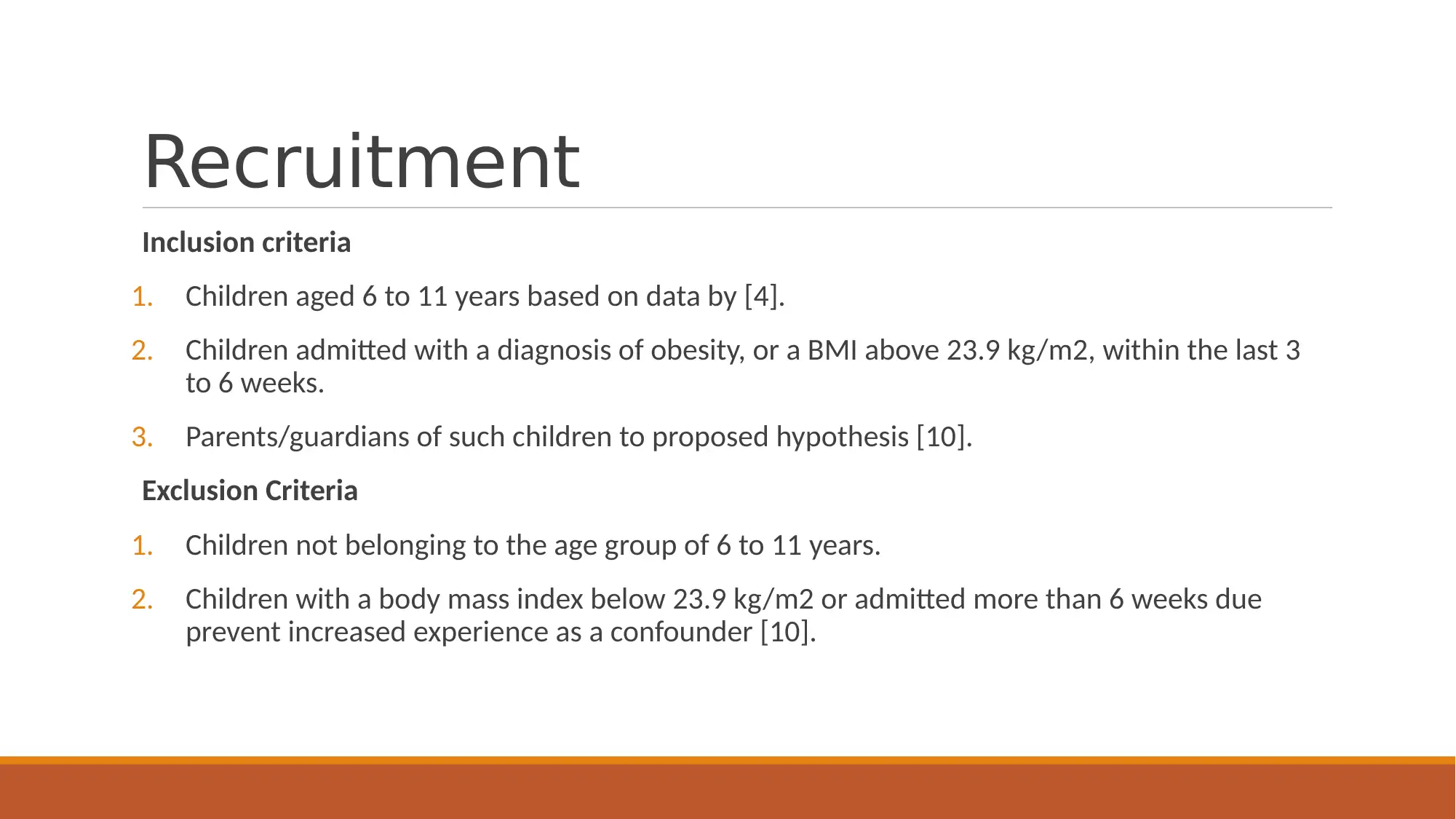
Recruitment
Inclusion criteria
1. Children aged 6 to 11 years based on data by [4].
2. Children admitted with a diagnosis of obesity, or a BMI above 23.9 kg/m2, within the last 3
to 6 weeks.
3. Parents/guardians of such children to proposed hypothesis [10].
Exclusion Criteria
1. Children not belonging to the age group of 6 to 11 years.
2. Children with a body mass index below 23.9 kg/m2 or admitted more than 6 weeks due
prevent increased experience as a confounder [10].
Inclusion criteria
1. Children aged 6 to 11 years based on data by [4].
2. Children admitted with a diagnosis of obesity, or a BMI above 23.9 kg/m2, within the last 3
to 6 weeks.
3. Parents/guardians of such children to proposed hypothesis [10].
Exclusion Criteria
1. Children not belonging to the age group of 6 to 11 years.
2. Children with a body mass index below 23.9 kg/m2 or admitted more than 6 weeks due
prevent increased experience as a confounder [10].
Paraphrase This Document
Need a fresh take? Get an instant paraphrase of this document with our AI Paraphraser
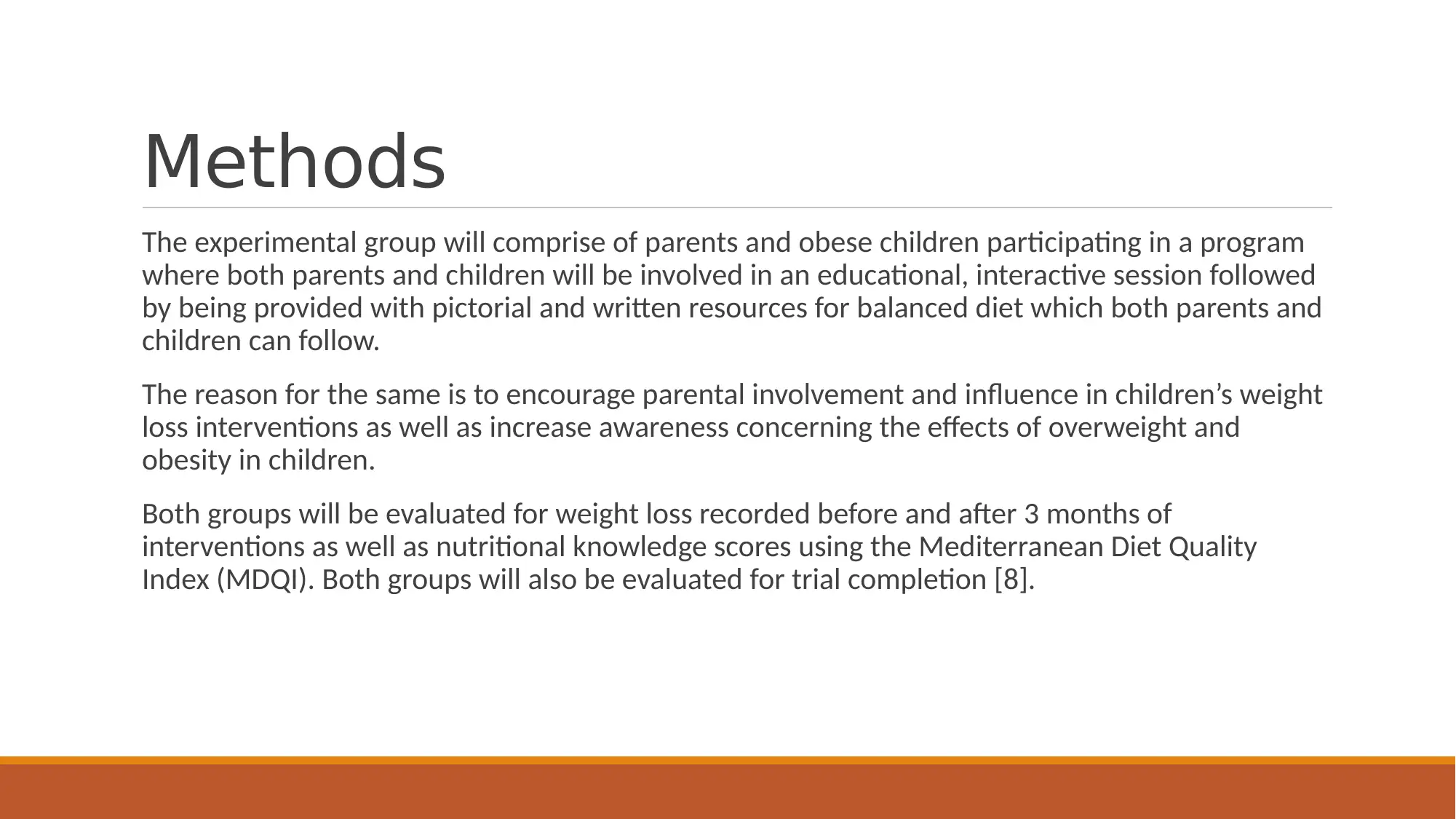
Methods
The experimental group will comprise of parents and obese children participating in a program
where both parents and children will be involved in an educational, interactive session followed
by being provided with pictorial and written resources for balanced diet which both parents and
children can follow.
The reason for the same is to encourage parental involvement and influence in children’s weight
loss interventions as well as increase awareness concerning the effects of overweight and
obesity in children.
Both groups will be evaluated for weight loss recorded before and after 3 months of
interventions as well as nutritional knowledge scores using the Mediterranean Diet Quality
Index (MDQI). Both groups will also be evaluated for trial completion [8].
The experimental group will comprise of parents and obese children participating in a program
where both parents and children will be involved in an educational, interactive session followed
by being provided with pictorial and written resources for balanced diet which both parents and
children can follow.
The reason for the same is to encourage parental involvement and influence in children’s weight
loss interventions as well as increase awareness concerning the effects of overweight and
obesity in children.
Both groups will be evaluated for weight loss recorded before and after 3 months of
interventions as well as nutritional knowledge scores using the Mediterranean Diet Quality
Index (MDQI). Both groups will also be evaluated for trial completion [8].

Outcomes
Demographics like weight, height, age, educational level, ethnicity and occupation of parents
and children who are participating will be first collected at baseline. Before and after the
intervention, weights of children for both groups will be collected. Before and after
participation, MDQI or nutritional knowledge scores of parents for both groups will be collected
[10].
Demographics like weight, height, age, educational level, ethnicity and occupation of parents
and children who are participating will be first collected at baseline. Before and after the
intervention, weights of children for both groups will be collected. Before and after
participation, MDQI or nutritional knowledge scores of parents for both groups will be collected
[10].
⊘ This is a preview!⊘
Do you want full access?
Subscribe today to unlock all pages.

Trusted by 1+ million students worldwide
1 out of 15
Related Documents
Your All-in-One AI-Powered Toolkit for Academic Success.
+13062052269
info@desklib.com
Available 24*7 on WhatsApp / Email
![[object Object]](/_next/static/media/star-bottom.7253800d.svg)
Unlock your academic potential
Copyright © 2020–2025 A2Z Services. All Rights Reserved. Developed and managed by ZUCOL.





